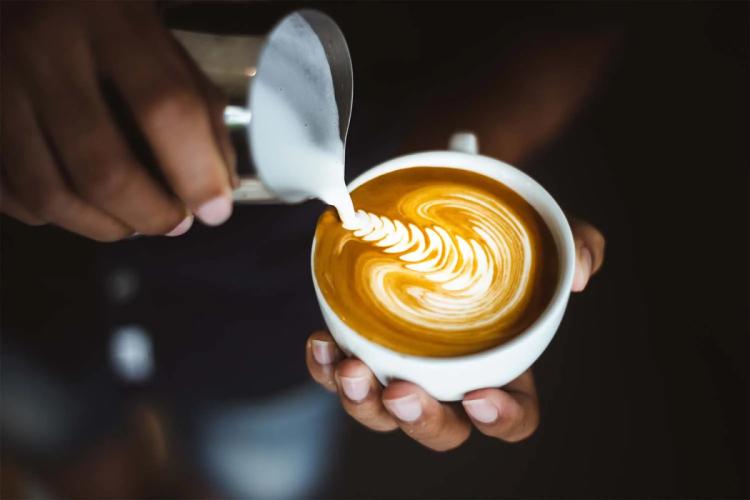
Is a Latte Hot or Cold & Which Is Best?
Summer is finally here, and with the rising temperatures, there is also a rise in demand for cold coffee drinks. Iced coffee and cold brew are excellent options, but are they the only cold coffee beverages available?
Today we will be diving into whether or not a latte is hot or iced, and which version of the latte is better.
What Makes a Latte Different From Coffee?
Coffee is a wonderful product that can be made in a plethora of different ways. Water temperature, grind size, coffee concentration, and extraction time can vary within the different styles of coffee drinks. These variances are especially notable when it comes to regular drip coffee drinks and espresso coffee drinks — such as a latte.
An espresso shot is small in stature, but it is not lacking in flavor or potency. First surfacing in the coffee world in Milan in 1905, espresso has made a lasting impression on the specialty coffee world. Let’s see what makes it so special.
Coffee Ratios
Like many specialty coffee processes, there are ratios and concentrations needed to produce a balanced beverage. The normal ratio for a regular cup of coffee is 1:16. That means, whatever unit of measurement you choose, you would have one part coffee for every 16 parts water.
For espresso, the ratio can range from 1:2 to 1:2.5. Espresso is served in shots that can be between one and three ounces, so it is a highly concentrated cup of coffee.
A double shot of espresso, which is two ounces of liquid, typically contains 18-20 grams of coffee. The amount of coffee used in espresso makes it especially strong, and it is typically diluted with just a little bit of water or milk.
A double shot of espresso is the standard for most espresso beverages; however, there are different espresso shot options, such as single shots, ristretto shots, and long shots, all of which vary in coffee concentration. Despite the various amounts of coffee used in a shot of espresso, they are always strong, potent, and rich in flavor.
Grind Size and Extraction Time
There is an analogy used in the coffee world called the “Rocks and Sand” analogy. When you pour water through rocks, the water goes through the rocks quickly. When you pour water through sand, the water moves slowly, and the sand absorbs some water.
This analogy is used to describe the proper grind size to use when “dialing in” espresso. When the grinds are too coarse, the water moves too quickly through the coffee. When the coffee grinds are too fine, the water moves too slowly.
Espresso must use finely ground coffee. The texture of the grinds should be closer to a powder as opposed to a handful of sand. This allows the perfect amount of extract from the coffee grounds to create a balanced flavor.
Water Temperature and Water Pressure
When coffee is made, water temperature affects the strength of the beverage. If the water is hot, more caffeine can be extracted from the coffee in a shorter period of time. Espresso is made through a pressurized extraction process that uses near-boiling water.
The espresso machine pressurizes the hot water and pushes it through a condensed puck of coffee grinds. This results in the thick concentration of coffee we know and love as espresso.
Caffeine Content
Another difference between espresso and coffee is the caffeine content. Since espresso is highly condensed, each shot of espresso (one to three ounces) contains from 30 to 50 milligrams of caffeine. The average cup of coffee (eight ounces) contains around 95 milligrams of caffeine.
Does this mean a cup of coffee has more caffeine than espresso? If you look at single servings, then yes. However, if we go by the amount of caffeine per ounce of coffee, espresso beats out regular drip coffee — hands down!
Additional Health Benefits
If you're thinking of switching up your morning coffee, you don’t have to give up the benefits of regular coffee! Espresso is rich in flavor and health benefits that extend far beyond an extra wake-up boost in the morning!
Espresso is linked with increasing focus and helping long-term memory. It is also known to contain many antioxidants that help with everyday body functions.
What Is a Latte?
Now that we have a background in espresso, we will dive into what makes a latte special. In the espresso drink world, almost every beverage contains milk. An americano is one of the only espresso beverages you can get that does not contain milk, other than a regular double shot of espresso.
A latte has espresso as a base, and it is topped with steamed milk. Isn’t that the same as a cappuccino? Technically, yes, a cappuccino and a latte have the same ingredients. However, the way the milk is steamed and the size of the beverage differentiate these two standard espresso beverages.
Steamed Milk
Milk froth is a common term used to describe milk added to espresso; however, it’s not the same as steamed milk. Steamed milk is made with a steam wand. The milk is only aerated slightly, and it is made through a whirlpool method. Steamed milk is signified by its microfoam.
To make milk froth, the milk needs to be aerated for a longer period of time, and it produces a macrofoam instead of microfoam. Macrofoam is thicker and lighter, and it contains bigger bubbles than microfoam.
Latte Sizes
As long as there is enough espresso to make up one-third of the beverage, a latte can come in any size. In contrast, most other espresso beverages have a strict ratio of espresso to milk. Cappuccinos, flat whites, and breves are all beverages that are typically one size.
A latte is a great way to have a strong cup of coffee without having to sacrifice any additional flavor. In the coffee world, it’s all about balance. The balance of espresso to milk is essential because espresso is meant to be tasted and enjoyed.
Does a Latte Have To Be Hot?
Despite a latte at its core being espresso with steamed milk, which is hot, a latte does not have to be only hot. Iced lattes can be made with espresso, cold milk, and ice! No flavor is lost, and it is a delicious alternative to have once the months grow unbearably warm.
Just pour the espresso into a cup, add cold milk, and top with ice, and you have an iced latte. Convenient and delicious, iced lattes are a great option in your daily coffee line-up! One latte option is not inherently better than the other because they are made of the same ingredients!
It depends on the personal preference of whether or not you enjoy your lattes with steamed milk instead of cold milk. Either way, you are not sacrificing any flavor or benefits. Coffee is great in any form, and you are the judge of how you want to drink it!
Is an Espresso Machine Necessary To Make a Latte?
Espresso machines are amazing devices that produce rich and flavorful coffee beverages. However, it is not very wallet-friendly to go to a coffee shop every day, nor is it practical for every person to purchase a state-of-the-art espresso machine. Luckily, there are delicious alternatives to espresso available so that everyone can enjoy an iced latte in the comfort of their own kitchen!
Coffee Concentrate
A shot of espresso from a machine is wonderful for lattes; however, coffee concentrate is an alternative that is just as flavorful. Coffee concentrate is made with a 1:1 ratio of coffee to water, and it results in a highly-condensed coffee base. Rich in flavor and made with the best type of coffee, coffee concentrates make it simple to make good coffee with ease.
Coffee concentrates are best to use when Coffee concentrates are best to use when Coffee concentrates are best to use when Coffee concentrates are best to use when Coffee concentrates are best to use when making an iced lattemaking an iced lattemaking an iced lattemaking an iced lattemaking an iced latte. However, a hot latte can be made with coffee concentrate as well. For those seeking a quick and easy latte option, coffee concentrates are available not only as regular coffee, but also as . However, a hot latte can be made with coffee concentrate as well. For those seeking a quick and easy latte option, coffee concentrates are available not only as regular coffee, but also as . However, a hot latte can be made with coffee concentrate as well. For those seeking a quick and easy latte option, coffee concentrates are available not only as regular coffee, but also as . However, a hot latte can be made with coffee concentrate as well. For those seeking a quick and easy latte option, coffee concentrates are available not only as regular coffee, but also as . However, a hot latte can be made with coffee concentrate as well. For those seeking a quick and easy latte option, coffee concentrates are available not only as regular coffee, but also as decafdecafdecafdecafdecaf and in a variety of flavors such as and in a variety of flavors such as and in a variety of flavors such as and in a variety of flavors such as and in a variety of flavors such as caramelcaramelcaramelcaramelcaramel, , , , , mochamochamochamochamocha, and , and , and , and , and maplemaplemaplemaplemaple.....
Make Your Own Latte
Now that you are knowledgeable about what a latte is and how it can be made, it’s time to make your own latte! Lattes are smooth, delicious, and a great coffee beverage option. They are excellent for any occasion and delicious any time of the year. The versatility of lattes makes them one of the best coffee options available!
Sources:
Five Benefits of Drinking Espresso Coffee Daily | Goodnet
The Faema E61 Espresso Machine | Perspectives on History | AHA




